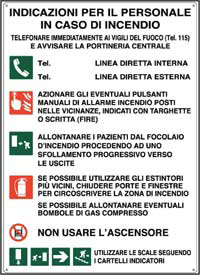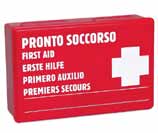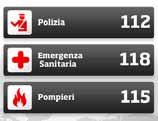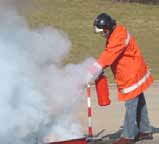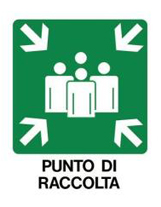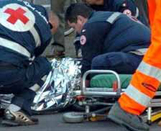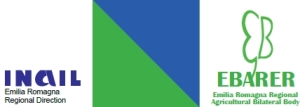Card 01.07 Emergency procedures
THE RISKS:
- Mistakes and hesitations which may harm someone (even the worker him/herself) and damage things
- Lack of systems/equipment/devices to grant people "First Aid"
- Inability to use systems/equipment/devices at worker's disposal
- Lack of one's self rights/duties knowledge
- Role underestimation
It is necessary to remind that:
In case of unwelcome events, such as start of a fire, accidents and indispositions, it is necessary that the farm is organized to face them,
and that everybody knows what to do/he/she shall do even if he/she is not in the "emergency team".
PRACTICAL AND OPERATING INDICATIONS:
Generally the Employer shall:
Know what to do in case of emergency (developing an Emergency Plan), such as: first aid, fire fighting, worker's evacuation and immediate/great hazard. If necessary, he shall arrange clear safety and warning signals.
Name workers in charge of prevention, fire fighting and first aid (usually in small farms, up to 5 workers, these tasks are performed
by the employer him/herself). Make sure everyone knows their names. People in charge must attend a specific course.
Equip facilities with:
- First-aid kit in the head quarters;
- One or more medipack son the transports which can be driven away from the headquarters (e.g. tractor, lorry etc);
- Fire extinguisher (at least 1 for every "dangerous place" that is an area with flammable materials which can harm people or damage things)
Place near the farm telephone a paper with the most important telephone numbers (115, 118 etc) and a "call model" to call for help in an proper and rational way, winning panic which can grow in those moments.
Let everyone know the established rules (Internal Emergency Plan) and create a farm map where worker can find: fire extinguishers, first-aid kits, locking systems (master switch and methane centralized valve) and the "meeting point".
In case of fire, the worker shall:
If he/she is member of the fire fighter team, he/she shall intervene on the spot and act following the common sense and the Course's directions.
If he/she is not member of the fire fighter team, he/she shall follow the Emergency Plan's directions. Usually he/she shall leave the working place or the dangerous zone and escape to the "gathering point". He/she shall be at fire fighter team's disposal calling Fire Brigades (tel. no.: 115)
In case of indisposition/faint/accident, the worker shall:
If he/she is member of the first aid team, he/she shall intervene on the spot and act following the common sense and the Course's directions. In general, he/she shall check the person's conditions and, if possible, put him/her in rest position, then call the ambulance (tel. no.: 118).
If he/she is not members of the first aid team, he/she shall escape and be at first aid's team disposal calling the ambulance (tel. no.: 118).
FURTHER INDICATIONS AND ADVICE
- It is suggested to carry out an "evacuation test" once a year (it is not always compulsory) with first aid and fire fighting simulations. It is suggested to keep evidence of them (in a paper with date, signature of both participants and employer, simulation descriptions etc)
| List of First-Aid kit content: | List of Medipack content: |
| disposable sterile gloves (5 pairs) | disposable sterile gloves(2 pairs) |
| splash-proof face visor | 125 ml cutaneous solution bottle of iodo-povidone at 10% iodine (1) |
| 1 l cutaneous solution bottle of iodo-povidone at 10% iodine (1) | 250 ml sterile saline bottle (sodium chloride 0,9%) (1) |
| 500 ml sterile saline bottles (sodium chloride 0,9%) (3) | individually wrapped sterile gauze pads 18 x 40 (1) |
| individually wrapped sterile gauze pads 10 x 10 (10) | individually wrapped sterile gauze pads 10 x 10 (3) |
| individually wrapped sterile gauze pads 18 x 40 (2) | disposable sterile tweezers(1) |
| disposable sterile sheets(2) | cotton wool pack(1) |
| disposable sterile tweezers(2) | individually wrapped sterile ready made plasters pack (assorted size) (1) |
| elastic net pack, medium size(1) | plaster rolls 2,5cm high(2) |
| cotton wool pack(1) | bandage roll 10 cm high (1) |
| individually wrapped sterile ready made plasters pack (assorted size) (2) | a pair of scissors (1) |
| plaster rolls 2,5 cm high(2) | tourniquet(1) |
| a pair of scissors | ready-made icepack(1) |
| tourniquets(3) | sanitary waste disposable bags(1) |
| ready-made icepack(2) | a leaflet giving general guidance on first aid while waiting for ambulance |
| sanitary waste disposable bags(2) | |
| thermometer | |
| sphygmomanometer |
Which fire extinguisher it must be used:
- powder extinguishers: they can be used every where, but they leave evident traces;
- carbon-dioxide extinguishers:next to main control panel and when it is necessary not to soil.
Where fire extinguisher shall be put (indicatively; in any case apply the specific fire prevention norms, if they exist, or stick to planner's indications):
- gas tank: no. 3, next to it (they can be used for other nearby areas, around 10-15 meters);
- LPG tank: no. 2, next to it;
- plant protection product depot: no. 1;
- barn for agricultural transport: no. 1 next to exits/main gates (an average of no. 1 each 150-200 m2);
- workshop: no. 1;
- hayloft: no. 1;
- transport and agricultural trucks (which can be driven away from the head quarters): no. 1 each.
It is necessary to remember that fire extinguishers must be controlled every 6 months by experts.
